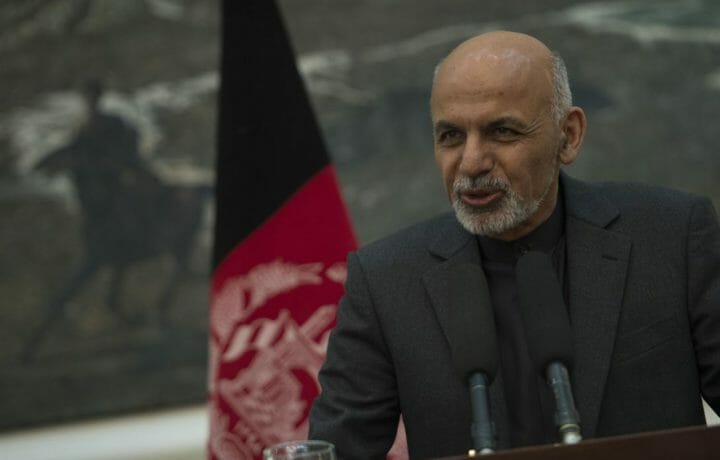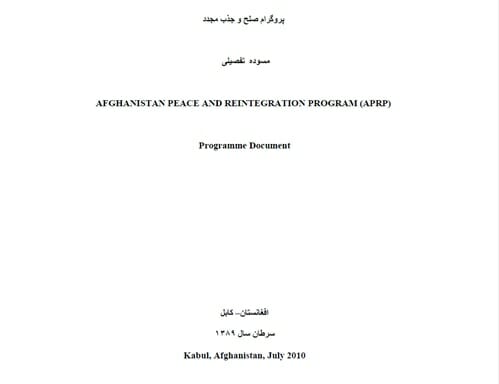In 2008, after an earlier failed British attempt to nudge the Taliban movement and Afghan government into peace talks, President Karzai took action himself. The flaw in the British attempt was that they didn’t allow the Afghan president to drive the outcomes. Afghans are allergic to foreign meddling, so it was not surprising that those talks went nowhere. When President Karzai started to make his own inquiries into peace talks with the Taliban movement, he faced a nation and international community that wasn’t ready for it.
Some Afghan civil society and government leaders saw what Karzai was doing and pushed for more transparency in his outreach with the Taliban movement. There were a lot of suspicions, and this demand was due to the sensitivities of the matter, especially for Afghan women. Brave women like Wazhma Frogh started to organize in Kabul to ensure that women’s rights were not negotiated away in the peace talks. The outreach didn’t get far under the Bush administration through the end of 2008.
In January 2009 President Obama came in to office on a campaign promise to set things right in Afghanistan. One of Obama’s first actions was to establish the Special Representative for Afghanistan and Pakistan (SRAP) to better coordinate the State department’s activities in Afghanistan and Pakistan as they related to the Afghan war. Obama appointed Richard Holbrooke on January 22, 2009. While not loved by Obama, he was very close to Clinton. The Peace talk idea was very much on Holbrooke’s mind, but he would have little traction getting D.C. and others to let him pursue that angle with full vigor.
In May 2009 President Obama picked General Stanley McChrystal to take over command of all forces in Afghanistan. I would arrive in D.C. in May to be his aide de camp through senate confirmation until he had completed his campaign review in Afghanistan. In early June we arrived in Kabul and began the Afghan campaign review. The same think-tank folks that would help McChrystal deliberate on his strategy in Kabul would later return to D.C. and advise SRAP Holbrooke in late summer and Fall 2009. Some ideas would pass from Kabul to D.C. in this way.
One of the missing pieces McChrystal inserted in his Afghan strategy was a reintegration and reconciliation program that could peel off enemy fighters and also eventually spur peace talks between the Taliban movement and Afghan government. The ISAF commander had heard from Karzai that it was the Afghan president’s goal to make diplomatic space for Afghan peace talks, but no one in the world seemed to want to back him. ISAF took that as a task: to make the world want to support the Afghan government in setting up eventual Taliban peace talks. McChrystal knew just who to pick for the job.
On June 15th Secretary of State Hillary Clinton gave a speech at the Council on Foreign Relations in which Ambassador Holbrooke was able to insert language about at least the idea of reintegration of Taliban fighters. This language tracked with the past Afghan reintegration programs I was privy to in 2002-03 and the one ISAF was envisioning in a more robust way in Kabul in June 2009. We would use that language as a baseline for an August ISAF white paper on reintegration and reconciliation that CENTCOM supported; and used to later push the White House towards giving Holbrooke more of a leash to start talking about peace talks.
Page 2-14 COMISAF’s Initial Assessment, August 2009, from the redacted copy released by DOD.
By August 2009 the US/ISAF campaign review was ready to go back to D.C.. The task of creating a reintegration program and using it to spur a peace talk opportunity fell to General Petraeus’ old deputy from Iraq. The man behind what was termed “reconciliation” in Iraq was Lt. Gen. Sir Graeme Lamb. He was the quiet shepherd of “the Awakening” to turn terrorist supporters into Iraq government supporters. So, in the early Summer of 2009 CENTCOM commander Dave Petraeus put retiring general Graeme Lamb on contract as an advisor to both the CENTCOM and ISAF commanders.
Lamb arrived in Kabul in August 2009, just after our enemies used a vehicle IED to blow the gates off the ISAF headquarters, and President Karzai assigned our two-man team to work with Minister Masoom Stanekzai to create a mechanism that would establish international support, and most importantly Afghan support for peace talks in the future. I had worked with Stanekzai on an earlier tour so we started off fast. This Afghan-ISAF task force had numerous sub-missions but the end goal was creating support for reintegration and eventual peace talks. The role of the Force-Reintegration Cell or F-RIC, was public and the force became a multinational and interagency NATO organization.
The Obama policy reviews were well underway by September 2009. While the D.C. crowd talked about surge force levels, the Afghan-ISAF reintegration team started to develop a plan that would create a robust reintegration and reconciliation program, gain international funding for it and acceptance of it, create a High Peace Council, and help the growing number of SRAPs in the world to find more space to talk about peace talks. That groundwork helped President Karzai to hold a peace jirga and gain national acceptance for future peace talks between the Afghan government and taliban leadership. The Afghan policy for reintegration, reconciliation and possible peace talks was published in the July 2010 as the Afghanistan Peace and Reintegration Program (APRP).
The ultimate goal of that document and all that groundwork was to make it possible for diplomats globally to engage with the Taliban and to get them to one day talk to the Afghan government. During the early days of developing the APRP Sir Graeme Lamb and Ambassador Richard Holbrooke met and they decided that while the ISAF team helped to craft the Afghan policy to create peace openings, Holbrooke would lead the global diplomatic effort to find those willing to set up peace talks.
All through 2009 and 2010 both leaders of their organizations would be responsible for travelling globally to find partners for Afghan peace and help each other secure more leeway from D.C., NATO, and London to push forward the idea of eventual Afghan-led and Afghan-owned peace talks. Few people knew of their arrangement. So, while the military and diplomatic corps were struggling in D.C. to develop a strategy for Obama in Afghanistan, Lamb and Holbrooke cut through the drama and devised a way to harness diplomatic and military power to find a path to peace talks. I think this deal worked out for Afghanistan’s president because so few knew what the actual plan was or about the collaboration between Lamb and Holbrooke.
President Karzai in less than a year got the international support, especially from Japan, that he needed to create an opening for future peace talks; the APRP spelled out everything he had asked for and more. Pakistan quickly took note of all these undertakings and worked to block outreach between the Taliban and Kabul. The Taliban created counter-mechanisms to fend off reintegration so it would not lose manpower and announced they would never talk to the Afghan government because it was a puppet regime in their eyes.
Both Pakistan and its proxy the Taliban in 2009 and 2010 believed they could militarily outlast the U.S. and one day defeat the still nascent Afghan military. That was their gamble, and it did not end as they thought it would, in a military victory. Most people observing the work of Karzai, ISAF, and the SRAP in 2009 and 2010 said it was a fool’s errand and that the Taliban would never even talk to the US. Some in the U.S. and other nations only paid lip service to the concept of Afghan-led and Afghan-owned peace talks and began reaching out directly to the Taliban without President Karzai’s approval. Just like the earlier British attempts before 2008, when you step forward, you sometimes slip backwards.
While the U.S. talks under Obama found the Taliban were not terribly interested in peace from 2009 to 2016, it did produce results. We made some important inroads with the help of Germany, Qatar, UAE, and Saudi Arabia in figuring out who might be interested in peace inside the Taliban movement. We also established some basic negotiation positions for the U.S. and Taliban. It all helped the US and other nations to share ideas about what “could be.” The Afghans were made aware of the progress throughout this time, although sometimes it was clumsily handled. The goal in those years after Holbrooke’s passing was still to get direct Afghan talks started; I think some solid work was done to get towards that goal.
In January 2017 President Trump came into office on a campaign promise to end the war in Afghanistan and bring our troops home. This was thought to make possible peace talks harder as we discussed the idea of reviving peace talks during the 2016-17 presidential transition. We decided not to designate the Taliban movement as terrorists, and to give peace talks one more try. I was called by people connected to the State Department on August 2, 2018 to give my thoughts on how the talks might restart, what to focus on, and who might best get the job done. Based on my inclusion in the original small group that started this process for President Karzai I had some ideas, so did others.
Ambassador Zalmay Khalilzad took on the role of the as the U.S. Special Representative for Afghanistan Reconciliation on September 21, 2018. President Ghani continued the work that President Karzai had begun in 2008 and the Afghan government continued to offer an olive branch to the Taliban for direct talks.
By now the Taliban had changed their tune about their ability to militarily defeat the now robust, professional, Afghan-respected, and capable ANDSF. Pakistan too was wondering if their goal of a pliable Kabul government was possible via their old hybrid-warfare strategy. The U.S. pushed harder for a deal all the while racing the clock not knowing the moment President Trump might tell our commander in Afghanistan to wrap it up and come home. After many fits and starts the general plan was developed and after over a decade of work it was signed.
Khalilzad performed a miracle, but was also helped immensely by the continuing offensive capability of the ANDSF that drove the taliban towards peace talks. Our nation cannot discount the role of the RS military forces, especially under General Nicholson and then General Miller, in getting the Afghan security forces into a high state of readiness and capability. The ANDSF sacrificed thousands of brave people as did the US-led coalition over 18 years to drive the Taliban and Pakistan to make the decision to end the war diplomatically instead of militarily.
Peace, Progress and a Potential Nobel Prize
While I have noted previously the hard work of hundreds of non-Afghans in getting the Afghan government and the Taliban movement into position to establish direct talks and a durable peace process, I do hope all diplomats and politicians step aside, if this warrants a Nobel Peace Prize. Many have angled for a peace prize in this conflict and others like it, but we must recognize who sacrificed the most.
I would like to see a group acceptance of the prize by a young Afghan woman that came of age after 2001, gold star families of the ANDSF, all the troop contributing nations, and some ANDSF members with their international advisors. No one has sacrificed more than the civilians caught in the crossfire of war and the military members and families who in many cases gave everything they had to achieve peace.






